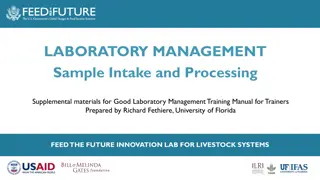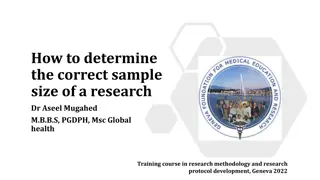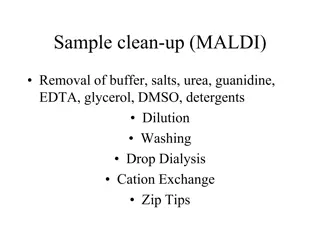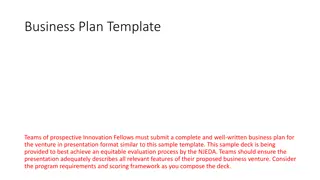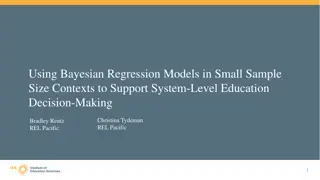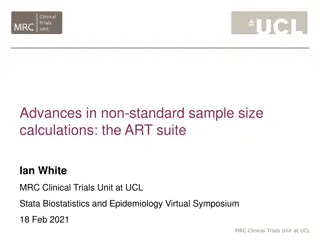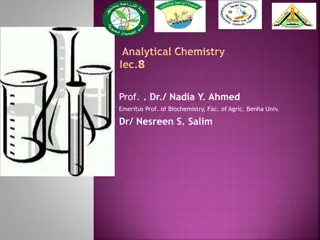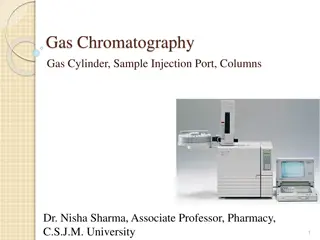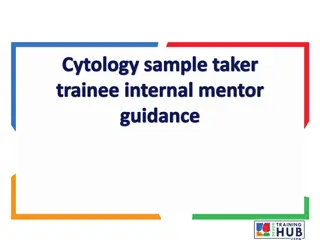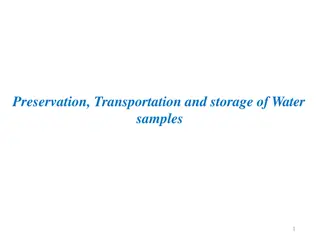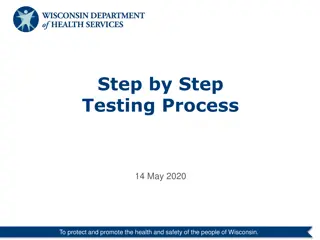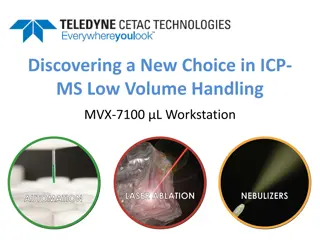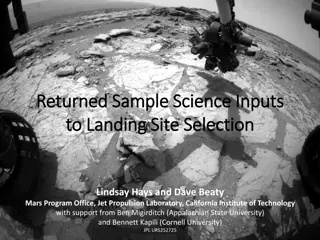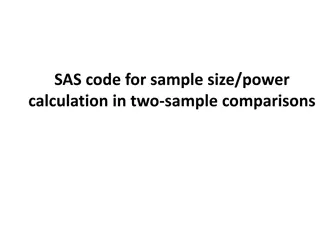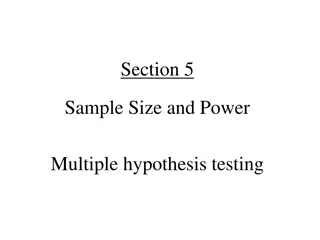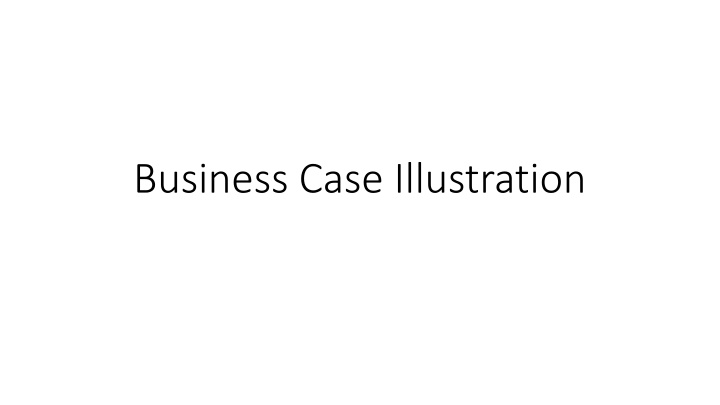
Maximizing Business Benefits Through Lean Improvements
Enhance business outcomes by implementing lean improvement actions across top programs, resulting in an additional capacity of 120-162 FTEs per year. The potential benefits range across various areas and programs, demonstrating a significant capacity improvement over five years.
Download Presentation

Please find below an Image/Link to download the presentation.
The content on the website is provided AS IS for your information and personal use only. It may not be sold, licensed, or shared on other websites without obtaining consent from the author. If you encounter any issues during the download, it is possible that the publisher has removed the file from their server.
You are allowed to download the files provided on this website for personal or commercial use, subject to the condition that they are used lawfully. All files are the property of their respective owners.
The content on the website is provided AS IS for your information and personal use only. It may not be sold, licensed, or shared on other websites without obtaining consent from the author.
E N D
Presentation Transcript
Business Case Benefits Using conservative estimates, additional capacity of 120 162 FTE s per year can be realized across 25 top and middle tier programs by implementing the complete set of lean improvement actions Areas of framework impacted Estimated benefit range per program per year Estimated benefits range across 25 top tier & middle tier programs per year Improvement Opportunities Hours Hours FTE Low High Low High Low High 1.0 Reduce churn by requirements traceability and prioritization in Teamcenter Systems Engineering 2,980 3,910 72,250 97,750 40 54 Product & Technology Roadmap Integrated Portfolio Management Performance Metrics Project Management (including planning and control) Common Processes & Engineering Change Control in Teamcenter Engineering Decomposition & Requirements Requirements Requirement Prioritization Traceability Definition 2.0 Reduce churn by better defining, prioritizing and freezing requirements by GW 3 935 1,265 23,401 31,660 13 18 Teamcenter Systems Engineering 3.0 Increase productivity by implementing standard engineering change process templates in Teamcenter Engineering 65,527 1,938 2,622 48,433 27 36 Product & Technology Roadmap Integrated Portfolio Management Performance Metrics Project Management (including planning and control) Common Processes & Engineering Change Control in Teamcenter Engineering Decomposition & Requirements Requirements Requirement Prioritization Traceability 4.0 Reduce non-value added time through implementation of standard processes, templates, common repositories and communication plans Definition 40,041 1,184 1,602 29,595 16 22 Teamcenter Systems Engineering Product & 5.0 Establish simple workplans in Teamcenter Project and roll-up to portfolio analysis using performance metrics Technology Roadmap Integrated Portfolio Management Performance Metrics Project Management (including planning and control) Common Processes & Engineering Change Control in Teamcenter Engineering 1,686 2,282 42,160 57,040 23 32 Decomposition & Requirements Requirements Requirement Prioritization Traceability Definition Teamcenter Systems Engineering Total 8,663 11,681 215,839 292,017 120 162 Total estimated annual benefits from improvement opportunities range from: $20.4 27.7 M
Improvement program value curve The value curve illustrates a significant capacity improvement that can be gained through targeted investments in the requirements management value stream Value Curve A five year horizon is used for benefit realization The value curve reflects the net hour benefit (hours) on a yearly basis The model assumes a benefit realization of 5%, 37% and 100% starting at year 1 Payback period is between 12 and 15 months Total potential net benefits of 762,000 engineering hours can be realized over five years 300,000 250,000 Net Benefit (Hours) 200,000 150,000 100,000 50,000 0 0 1 2 3 4 5 Time (Years) (50,000)
Product & Technology Roadmap Integrated Portfolio Management Performance Metrics Project Management (including planning and control) Improvement Opportunity 1.0 Common Processes & Engineering Change Control in Teamcenter Engineering Decomposition & Requirements Requirements Requirement Prioritization Traceability Requirements Traceability and Prioritization:Reduce churn by requirements traceability and prioritization Definition Teamcenter Systems Engineering Recommendation Details Priority Deploy Teamcenter Systems Engineering functionality. Process design and definition should be central to the Teamcenter deployment activities Conduct broad deployment to all level 4 programs Provide Teamcenter SE access to all engineers on these programs, enabling them to directly manage all requirements in the application Uniquely identify requirements by number During definition, each requirement should be assigned a unique identifier to which associated artifacts are linked (specs, docs, changes, etc..) Assign one owner per requirement Each requirement should have one clear owner who assumes total responsibility for definition, linkage, issue identification / resolution and sign-off Define traceability by upstream and downstream dependencies The ability to track requirements and their associated designs, applications and test cases is essential to understanding and managing the impact of change Set and record the priority of each requirement / feature within Teamcenter to ensure appropriate effort is allocated to activities High Impact Benefits Range Low High Hours Per Year 72,250 97,750 FTEs Per Year 40 54 Deployment Resources Equivalent Hours FTEs Months Full-Time Resources Pilot / Full Pilot / Full 2 9 / 10 2700 / 3000 Part-Time Resources 1.5 4 2771
Product & Technology Roadmap Integrated Portfolio Management Performance Metrics Project Management (including planning and control) Benefits 1.0 Common Processes & Engineering Change Control in Teamcenter Engineering Decomposition & Requirements Requirements Requirement Prioritization Traceability Definition Reduce churn by requirements traceability and prioritization in Teamcenter Systems Engineering Teamcenter Systems Engineering Assumptions Data was gathered based on interviews with engineers at multiple levels of the product structure Number of people per program = 15.8 (based on 25 NPI programs before gateway 3 and lifetime estimate of $235M Data for reducing churn based on analysis of Monarch release data Estimated benefit per program per year Estimated benefits per year across 25 top tier and middle tier programs Opportunity description Hours Hours FTE Low High Low High Low High Reduce churn by requirements traceability and prioritization in Teamcenter Systems Engineering 2,980 3,910 72,250 97,750 40 54 Net Benefits Across Programs (Average Hours) Yr 1 Yr 2 Yr 3 Yr 4 Yr 5 Total Benefit Realization (135) 29,040 85,000 85,000 85,000 283,905 Full Time Resources Part Time Resources Deployment phase FTE Months Hours FTE Months Hours Costs & Assumptions Detailed planning, design, configure, test & pilot 2 9 2,700 - - - Training and deployment to remaining projects 2 10 3,000 1.5 4 1,385
Product & Technology Roadmap Integrated Portfolio Management Performance Metrics Project Management (including planning and control) Benefits 1.0 Reduce churn by requirements traceability and prioritization in Teamcenter Systems Engineering Common Processes & Engineering Change Control in Teamcenter Engineering Decomposition & Requirements Requirements Requirement Prioritization Traceability Definition Teamcenter Systems Engineering Additional Soft Benefits Not Quantified Improved quality and reduced field failure issues Streamlined and automated process with increased adherence Improved ability to manage customer requirements and the impact of changes across business units Improved responsiveness to market changes Mitigation of confusion and misinterpretation due to clear, consistent format in capturing and communicating requirements Provides common direction for multi-site project collaboration and drives product design Visibility into all open requirements allows prioritization and resource allocation Improved ability to de-scope project to meet shortened timeframes Better ability to integrate machine programs
Product & Technology Roadmap Integrated Portfolio Management Performance Metrics Project Management (including planning and control) Improvement Opportunity 2.0 Common Processes & Engineering Change Control in Teamcenter Engineering Decomposition & Requirements Requirements Requirement Prioritization Traceability Definition Prioritize and Freeze Requirements: Reduce churn by better defining, prioritizing and freezing requirements by GW 3 Teamcenter Systems Engineering Recommendation Details Priority Define the sub-system and system scope of work and its respective dependencies Identify 2 - 3 lead customers/users at product launch with product segment knowledge of features and functions to define machine features that are critical to customer needs including: Value indicates the relative benefit to the customer Cost design and development, testing, materials, etc Risk rating based on factors including, but not limited to complexity, supplier risk, reuse potential, etc Timeframe indicates design and development duration Resource requirements identify effort and skill required to complete design and development activities Dependencies linkage between sub-systems and systems Engineers should have flexibility to define requirements and specifications such that downstream users understand form, fit, function and dependencies Finalized requirements are contingent upon downstream approval; ensuring that content is suitable for lower level requirement, design and test case definition Employ rigorous controls starting at product launch and freeze requirements at each level of the product structure starting from machine features, system requirements, sub-system requirements and technical specifications to ensure all requirements are frozen at GW 3. Post GW 3, all changes are formally and rigorously controlled via the engineering change process Map high level customer requirements to machine features and decompose functional requirements to the sub-system and component levels Progressively lock requirements at each stage of the product hierarchy to ensure major requirements are set in order to reduce churn during requirements development, engineering design and development, and testing Conduct meetings involving relevant cross-functional teams with emphasis on locking requirements and identifying interface conditions at each level Low Impact Benefits Range Low High Hours Per Year 23,401 31,660 FTEs Per Year 13 18 Deployment Resources Equivalent Hours FTEs Months Full-Time Resources Pilot / Full Pilot / Full 2 9 / 10 2700 / 3000 Part-Time Resources 4 2 1385
Product & Technology Roadmap Integrated Portfolio Management Performance Metrics Project Management (including planning and control) Reduce churn by better defining, prioritizing and freezing requirements by GW 3 Benefits 2.0 Common Processes & Engineering Change Control in Teamcenter Engineering Decomposition & Requirements Requirements Requirement Prioritization Traceability Definition Teamcenter Systems Engineering Assumptions Data for top tier and middle tier programs which are before GW 3 have been used to estimate the benefits Currently 25 NPI programs are pre GW 3 and with a lifetime estimate of $235 M Hours per year FTE = 1,800 Data for reducing churn based on analysis of Monarch release data Estimated benefit per program per year Estimated benefits per year across 25 top tier and middle tier programs Opportunity description Hours Hours FTE Low High Low High Low High Reducing 15% churn beyond GW 3 through improved requirements definition 935 1,265 23,401 31,660 13 18 Net Benefits Across Programs (Average Hours) Yr 1 Yr 2 Yr 3 Yr 4 Yr 5 Total Benefit Realization (3,009) 4,615 27,530 27,350 27,350 84,197 Full Time Resources Part Time Resources Deployment phase FTE Months Hours FTE Months Hours Costs & Assumptions Detailed planning, design, configure, test & pilot 2 9 2,700 - - - Training and deployment to remaining projects 2 10 3,000 2 4 1,385
Product & Technology Roadmap Integrated Portfolio Management Performance Metrics Project Management (including planning and control) Benefits 2.0 Reduce churn by better defining, prioritizing and freezing requirements by GW 3 Common Processes & Engineering Change Control in Teamcenter Engineering Decomposition & Requirements Requirements Requirement Prioritization Traceability Definition Teamcenter Systems Engineering Additional Soft Benefits Not Quantified Improved quality and reduced field failure issues Streamlined and automated process with increased adherence Reduction in information search time Improved ability to manage customer requirements and the impact of changes across business units Increased customer satisfaction Improved responsiveness to market changes Mitigation of confusion and misinterpretation due to clear, consistent format in capturing and communicating requirements Provides common direction for multi-site project collaboration and drives product design Visibility into all open requirements allows prioritization and resource allocation Improved ability to de-scope project to meet shortened timeframes Better ability to integrate machine programs
Product & Technology Roadmap Integrated Portfolio Management Performance Metrics Project Management (including planning and control) Improvement Opportunity 3.0 Standard Engineering Change Process: Increase productivity by implementing standard engineering change process templates in Teamcenter Engineering Common Processes & Engineering Change Control in Teamcenter Engineering Decomposition & Requirements Requirements Requirement Prioritization Traceability Definition Teamcenter Systems Engineering Recommendation Details Priority Implement a single change control and validation process for use on released objects (requirements, software, components, designs, etc) All change requests should be communicated to directly affected resources (as identified through requirements traceability) at the time of the change, and all changes should be reflected in the project plan Change control and validation should include a standard change request template with a unique identifier, name, description, change cause code (from standard list), value / cost of making the change, implications, and identification of impacted functions The approval process should include affect on timing, quality, budget, staffing and associated risks Define change governance and approval guidelines based on the following criteria: Change control procedures should focus on the size of impact (hours of effort required) and the reason for the change All changes are documented All changes are reviewed by all dependent functions (per the requirements family tree) Changes that exceed a specific budget / resource threshold must be reviewed and have concurrence from the program leader Past GW 3, the change control approval process should become more stringent, requiring higher levels of approval Aging of open design changes must be tracked to ensure quick response to, and resolution of the issue Capture the following reason codes for all changes to manage rood causes of engineering: High Impact Benefits Range Low High Hours Per Year 48,433 65,527 FTEs Per Year 24 32 Deployment Resources Equivalent Hours FTEs Months Full-Time Resources Initial release Specification change Supplier requested change Change of supplier Cost reduction Quality input Design error correction Design interference / integration Manufacturing requested change Test results failure Styling change request Customer satisfaction Pilot / Full Pilot / Full 2 9 / 10 2700 / 3000 Part-Time Resources 3.5 6 1575
Product & Technology Roadmap Integrated Portfolio Management Performance Metrics Project Management (including planning and control) Benefits 3.0 Increase productivity by implementing standard engineering change process templates in Teamcenter Engineering Common Processes & Engineering Change Control in Teamcenter Engineering Decomposition & Requirements Requirements Requirement Prioritization Traceability Definition Teamcenter Systems Engineering Assumptions Data was gathered based on interviews with engineers at multiple levels of the product structure for the Catalyst program Average time wasted per person dealing with documentation of changes = 1.35 hours / week Number of people per program = 15.8 (based on 25 NPI programs before gateway 3 and lifetime estimate of $235M Percentage reduction of at least 25% is possible from standardized documentation of changes Estimated benefit per program per year Estimated benefits per year across 25 top tier and middle tier programs Opportunity description Hours Hours FTE Low High Low High Low High Reducing churn using standard change processes and templates in Teamcenter Engineering 1,734 2,346 43,350 58,650 24 32 Non-value added time spent in looking for documentation of changes 530 718 5,083 6,877 3 4 Total 1,686 2,282 48,433 65,527 27 36 Net Benefits Across Programs (Average Hours) Yr 1 Yr 2 Yr 3 Yr 4 Yr 5 Total Benefit Realization (1,426) 17,242 56,980 56,980 56,980 186,756 Full Time Resources Part Time Resources Deployment phase FTE Months Hours FTE Months Hours Costs & Assumptions Detailed planning, design, configure, test & pilot 2 9 2,700 - - - Training and deployment to remaining projects 2 10 3,000 1.5 6 1,575
Product & Technology Roadmap Integrated Portfolio Management Performance Metrics Project Management (including planning and control) Benefits 3.0 Common Processes & Engineering Change Control in Teamcenter Engineering Decomposition & Requirements Requirements Requirement Prioritization Traceability Definition Increase productivity by implementing standard engineering change process templates in Teamcenter Engineering Teamcenter Systems Engineering Additional Soft Benefits Not Quantified Improved ability to manage customer requirements and the impact of changes across business units Enhanced supplier integration due to use of standardized change processes and templates Mitigation of confusion and misinterpretation due to clear, consistent format in capturing and communicating changes in requirements and design and development Improved design integration via clear visibility into the impact and effect of changes within different levels of the product structure
Product & Technology Roadmap Integrated Portfolio Management Performance Metrics Project Management (including planning and control) Improvement Opportunity 4.0 Standard Processes, Templates, Common Repositories: Reduce non-value added time through implementation of standard processes, templates, common repositories and communication plans Common Processes & Engineering Change Control in Teamcenter Engineering Decomposition & Requirements Requirements Requirement Prioritization Traceability Definition Teamcenter Systems Engineering Recommendation Details Priority Create templates to standardize structure rather than content for each system, sub- system and component level to ensure the same amount and type of detail per document Create and leverage templates for specifications, diagrams, meeting minutes and agendas Each template should contain a table of contents, sample narrative text and same diagrams at the appropriate level of detail Create a centralized repository to manage all documentation; templates, drafts and final documents Publish all documents in a common, centralized location to ensure accessibility, version control of all drafts and specification history Provide access to all engineers participating in the creation or validation of the specification Common repository features should include full text searches and revision control Re-orient current cross-functional meetings from a planning / coordination focus to a requirement creation focus Designate a single physical location from which all requirement definition activities will be executed for each sub-system Efficiently create requirements while incorporating all stakeholders expertise during a focused kick-off session Sessions should include system and sub-system architecture and technical leads and technical domain owners, all of whom having appropriate authority to expedite decision making. SMEs, system and sub-system engineers are invited as needed for specific topical discussions Medium Impact Benefits Range Low High Hours Per Year 29,595 40,041 FTEs Per Year 16 22 Deployment Resources Equivalent Hours FTEs Months Full-Time Resources Pilot / Full Pilot / Full 2 9 / 10 2700 / 3000 Part-Time Resources 6 2 1575
Product & Technology Roadmap Integrated Portfolio Management Performance Metrics Project Management (including planning and control) Improvement Opportunity 4.0 Continued Common Processes & Engineering Change Control in Teamcenter Engineering Decomposition & Requirements Requirements Requirement Prioritization Traceability Definition Teamcenter Systems Engineering Recommendation Details Assign technical domain owners / experts by system, sub-system and component to manage specification development process, mentor new resources and facilitate integrated requirements definition meetings Create one leadership position per technical domain per program for tenured engineers to oversee specification development L3e examples include Fuel Systems, Speed/Timing Systems, After Treatment Systems, Air Systems, etc Select technical domain leaders based on depth of knowledge in a specific area (e.g. 10+ years experience), interest in providing longer term continuity in that area, ability to perform critical technical reviews and mentorship abilities Having these experts in place is essential to knowledge sharing and integration. Given the high percentage of unfilled roles (~60%), CATe should apply creativity to align engineers with these roles. Each situation should be tailored to an individual engineers career experience and aspirations
Product & Technology Roadmap Integrated Portfolio Management Performance Metrics Project Management (including planning and control) Benefits 4.0 Common Processes & Engineering Change Control in Teamcenter Engineering Decomposition & Requirements Requirements Requirement Prioritization Traceability Definition Reduce non-value added time through implementation of standard processes, templates, common repositories and communication plan Teamcenter Systems Engineering Assumptions Data was gathered based on interviews with engineers at multiple levels of the product structure for the Catalyst program Average time wasted per person dealing with requirement changes = 3.45 hours / week Average time spent due to incomplete / inadequate requirements = 3.10 hours / week Number of people per program = 15.8 (based on 25 NPI programs before gateway 3 and lifetime estimate of $235M) Estimated benefit per program per year Estimated benefits per year across 25 top tier and middle tier programs Opportunity description Hours Hours FTE Low High Low High Low High Benefits through implementation of standard processes, templates, common repositories and communication plan 1,184 1,602 29,595 40,041 16 22 Net Benefits Across Programs (Average Hours) Yr 1 Yr 2 Yr 3 Yr 4 Yr 5 Total Benefit Realization (2,534) 7,823 34,818 34,818 34,818 109,743 Full Time Resources Part Time Resources Deployment phase FTE Months Hours FTE Months Hours Costs & Assumptions Detailed planning, design, configure, test & pilot 4 9 2,700 - - - Training and deployment to remaining projects 4 10 3,000 2 6 1,575
Product & Technology Roadmap Integrated Portfolio Management Performance Metrics Project Management (including planning and control) Benefits 4.0 Common Processes & Engineering Change Control in Teamcenter Engineering Decomposition & Requirements Requirements Requirement Prioritization Traceability Definition Reduce non-value added time through implementation of standard processes, templates, common repositories and communication plan Teamcenter Systems Engineering Additional Soft Benefits Not Quantified Improved supplier integration Streamlined product development processes leading to increase in personal and organizational productivity Improved visibility and access to product information Increase use of prior work documents, requirements and designs on future programs Shortened learning curves from standard processes
Product & Technology Roadmap Integrated Portfolio Management Performance Metrics Project Management (including planning and control) Improvement Opportunity 5.0 Project and Portfolio Management: Establish simple workplans in Teamcenter Project and roll-up to portfolio analysis using performance metrics Common Processes & Engineering Change Control in Teamcenter Engineering Decomposition & Requirements Requirements Requirement Prioritization Traceability Definition Teamcenter Systems Engineering Recommendation Details Priority Prioritization / Sequencing Product & Technology Roadmaps Develop a cross-functional consensus on technology roadmaps to drive portfolio & project planning Establish clear sponsorship and governance to drive execution Technology roadmaps for CAT Electronics should be presented to the Product Group NPI teams to set the direction for how and when specific technology will be available to future machine programs On an annual basis, utilize product and technology roadmaps to communicate business, technology and product plans to team members, management, customers and suppliers Prioritization / Sequencing Portfolio Management Establish a baseline understanding of the true capacity of CAT Electronics Establish clear sponsorship and governance of portfolio prioritization and execution Synchronization / Timing Define a simple/standard workplan to define, develop, test, and validate each unique requirement Program Management PMO (1) realign the current PMO org to directly support portfolio mgmt and allocate program/project management leads to specific programs; (2) allocate PMO pool to programs Project and Resource Planning Establish a governance and incentive structure so that all engineers across each development program perform the necessary to project management activities as part of their daily work Medium Impact Benefits Range Low High Hours Per Year 42,160 57,040 FTEs Per Year 23 32 Deployment Resources Equivalent Hours FTEs Months Full-Time Resources Pilot / Full Pilot / Full 4 6 / 3 3600 / 1800 Part-Time Resources 3.2 3.5 1680



